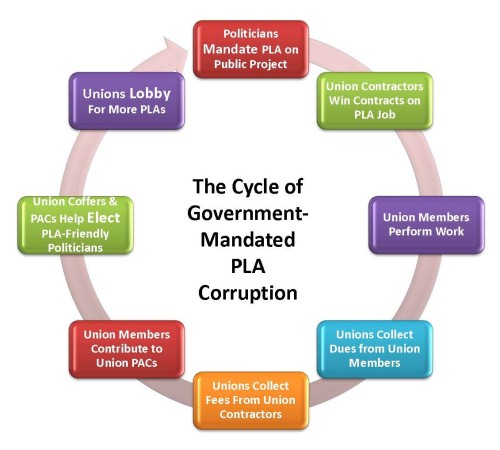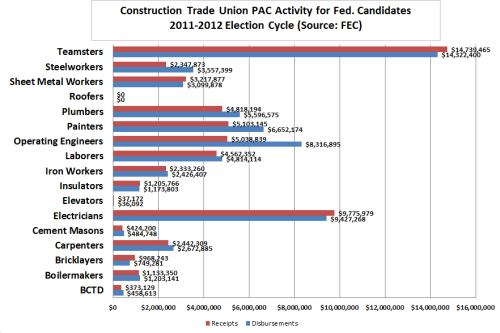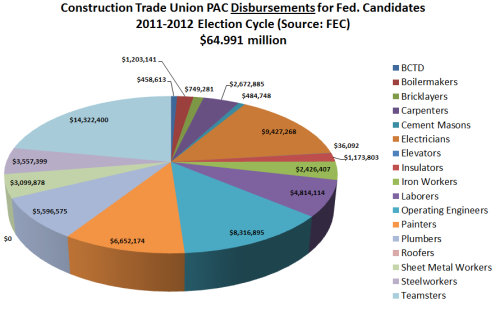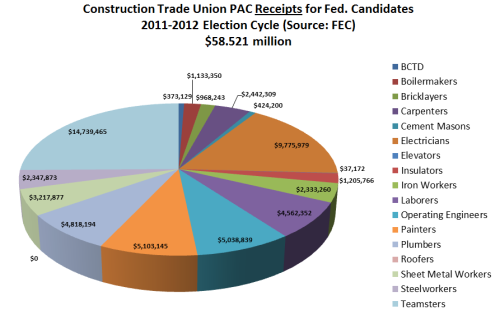Tappan Zee Bridge Project Labor Agreement Fuels Cycle of Political Cronyism in Public Contracting
Last week, a Newsday article reported that a government-mandated project labor agreement (PLA) for construction of New York’s federally and state-funded Tappan Zee Bridge will result in a multi-million-dollar windfall for construction union political action committees (PACs) and their crony beneficiaries in government (“Tappan Zee project to boost unions’ political action funds,” 6/17/13):
When Gov. Andrew M. Cuomo first announced the project labor agreement for the new Tappan Zee in June 2012, he hailed it as a framework that would provide thousands of jobs for unionized Hudson Valley workers while extracting a promise from union leaders that work stoppages and other labor-management disputes wouldn’t bog down construction of the new $3.9 billion bridge. The agreement could save as much as $450 million, he claimed.
A review of the 1,000-page project labor agreement illustrates why the unions might have agreed to the deal.
Most of the unions’ collective bargaining contracts contained in the agreement detail how a few cents from workers’ paychecks can be deposited to political action committees. The contracts also often contain special revenue streams — usually around 35 cents per hour worked — for “industry advancement” funds that pay for union programs and help unions lobby for work on public contracts. [snip]
An estimated 3,400 workers in traditionally unionized occupations are forecast to work on the new Tappan Zee Bridge, according to a May study by Empire State Development and the New York State Department of Labor.
The number of workers on the bridge project is expected to rise and fall at different times depending on construction needs. But according to Newsday calculations, if every estimated unionized worker on the bridge contributed 5 cents an hour to a PAC while working 40 hours a week for the entire five-year duration of the project, they’d generate almost $1.77 million.
In January, the laborers’ PAC had about $52,000, according to its most recent filing with the state Board of Elections. Since the 2010 statewide election, however, the PAC has contributed hundreds of thousands of dollars to political candidates, mostly to Democrats though occasionally to Republicans as well.
An analysis by the New York Public Interest Research Group found that from 2007 to 2010, when Cuomo, a Democrat, launched his successful bid for governor and took office, unions donated nearly $2.1 million to his campaign. [snip]
“All of this reflects a strong commitment to basically make the Tappan Zee an enormous gift to organized labor,” said McMahon. “His strategy is to pull off big infrastructure projects, which is a general goal a lot of people share. He’s also using it to further strengthen his ties to organized labor.”
Unfortunately, this political cronyism is all too familiar to TheTruthAboutPLAs.com readers. It is part of the cycle of PLA corruption that has resulted in the increased use of government-mandated PLAs, which has resulted in needless waste, discrimination and cronyism. 
The cycle of PLA corruption is one of the main reasons President Obama issued Executive Order 13502 in 2009, which encourages federal agencies, on a case-by-case basis, to require PLAs on large-scale federal construction projects exceeding $25 million in total costs.
More government-mandated PLAs results in more money flowing into union PACs and other slush funds that are used to support primarily Democrat politicians.
A recent review of disbursements and receipts of construction trade union PACs affiliated with national unions typically signatory to PLAs illustrates the influence of union money in federal politics.

According to reports filed by union PACs with the Federal Election Committee (FEC), 17 national construction union PACs disbursed $64.991 million to federal candidates in the 2011-2012 election cycle.
They raised $58.21 million in the 2011-2012 election cycle.
Data from The Center for Responsive Politics indicates 88 percent of construction trade union PAC dollars went to Democrat politicians in the 2011-2012 election cycle.
In a keynote address at the Building and Construction Trades Department’s (BCTD) 2013 Legislative Conference, BCTD President Sean McGarvey said:
“During the 2012 election cycle, the Building Trades… including the Operating Engineers and the Carpenters…were the No. 1 overall hard dollar PAC contributor; the No. 1 hard dollar PAC contributor to the Democratic Party; and the No. 4 hard dollar PAC contributor to the Republican Party.”
These astounding figures do not include other sources of Big Labor’s money in federal politics, such as:
- federal PAC dollars raised by local unions and unionized contractors;
- “soft money” raised by national and local unions and unionized contractors for pro-labor 527 groups that run issue-specific ads shaping opinions about candidates;
- lobbying expenditures for staff and other activities to advance the pro-PLA agenda; and
- money raised via employer and employee contributions to Labor Management Cooperation Committees (LMCCs), which are largely unregulated slush funds authorized by the Labor-Management Cooperation Act of 1978, a law signed by President Jimmy Carter and implemented by the Federal Mediation and Conciliation Service. (See how LMCCs spend in California here.)
Similar analysis of the influence of construction trade union political spending in state politics could be easily duplicated and would likely show similar results on a smaller scale.
The key takeaway from this analysis: Through government-mandated PLAs, construction trade unions and their pals in government engage in symbiotic mutualism at the expense of everyone else.
There are valid economic and ethical reasons why promoting the special interests of Big Labor, which composes just 13.2 percent of the U.S. private construction workforce, ahead of the needs of the rest of the construction industry is bad public policy.
For example, PLAs typically increase the cost of construction between 12 percent and 18 percent compared to similar non-PLA projects. With the added cost premium of PLAs, fewer construction dollars are available. And fewer dollars means fewer total construction projects and construction jobs. So union-favoring PLAs worsens the construction industry’s unemployment rate—which peaked at 27.1 percent in February 2010 and stands at 10.1 percent currently (although economists say the real unemployment rate is still in the high teens because many have found work in other industries).
In addition, there is no compelling reason (other than political self-interest) to create jobs for union members ahead of qualified nonunion employees via PLAs. Nonunion employees deserve just as fair a shot to feed their families as union members. Unions should use the ultra-competitive market and tough economy as an opportunity to retool their product and make it more lean and efficient to compete in today’s marketplace instead of relying on government handouts to stay relevant.
The U.S. economy and the construction industry would benefit from free and open competition, without corrupt government-mandated PLAs, where taxpayers can enjoy the best possible construction product at the best possible price.
For more info on the Tappan Zee PLA:
- Tappan Zee Bridge PLA 2012
- Union Collective Bargaining Agreements Referenced in the Tappan Zee PLA Schedule A
- All procurement information on the Tappan Zee Bridge is available here.
- Packet of background materials on the Tappan Zee Bridge PLA













